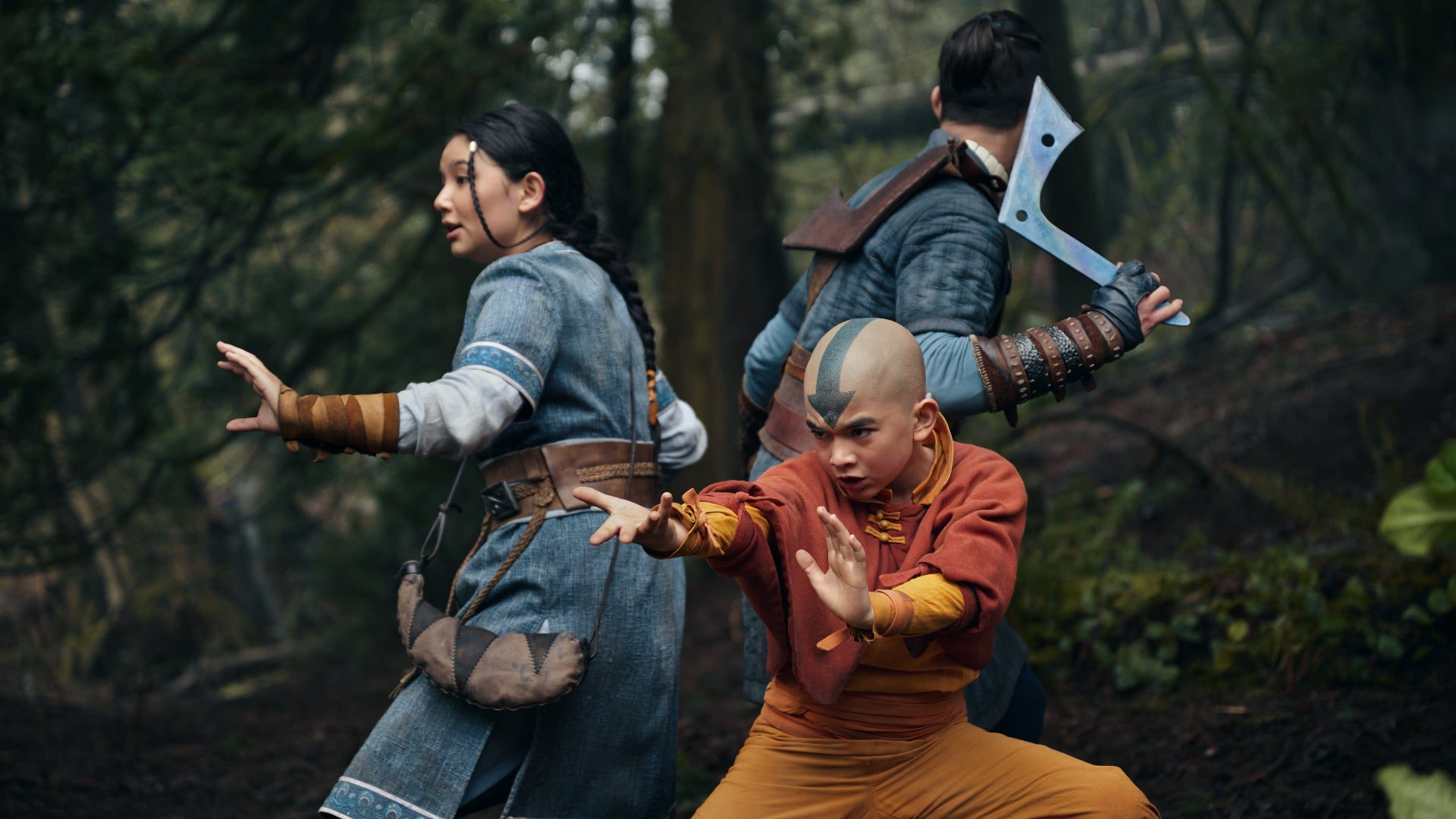I had the amazingly good fortune as an 11 year old boy to be seated in front of the television in our basement on February 21, 2005, for the long-awaited premiere of Avatar: The Last Airbender. Over the past few months, the ads for the new fantasy series had played on Nickelodeon, over and over, taunting me. Soon! When the show finally arrived, my own expectations were exceeded, and I was glued to that TV for every following episode, even scheduling my homework around air times.
I remember being curled up in front of the TV as I saw The Crossroads of Destiny, and having friends over to watch The Day of Black Sun, and talking about Sozin’s Comet at school for weeks on end after the perfect finale. And years after that, The Legend of Korra came, and you can bet I was hunched over my college laptop refreshing Nick.com every Friday night at 8. All this to say, Avatar the Last Airbender has always very important to me. As a 30 year old man it is now more important to me than ever. It’s important to a lot of people, and it’s important to the world. It is important that you watch it.

Avatar The Last Airbender is a show for children, but the depth and complexity of its themes are impossible for children to grasp the brilliance of. At its core, Avatar is a story of war, and is defined by its presentation of genocide, death, betrayal, racism, feminism, friendship, and guilt in a way that kids can absorb, even if they don’t fully understand it. I think Avatar is largely a story about second chances though, and making the most of the second chance you’re given. Aang ran away from his responsibility to save the world 100 years ago, but he has a second chance to save this one. Katara couldn’t save her mother, but she can carry on her tribe’s heritage, and no one will stand in her way. Sokka couldn’t protect his village as his father charged him, but he will protect the world. Zuko is maimed and abused by his father, but in seeking a second chance at his approval he finds himself. And Iroh – Iroh gets a second chance to raise a son. It pains me that none of this is present in the Netflix version.
I’ve watched Avatar on my own at least a dozen times, and probably two dozen additional times through reaction channels, learning more about the brilliance of this artwork each time. Some things may not pop the first time; for instance, Aang and Zuko’s parallel journeys. Our hero and our villain (for season 1) are largely the same. They are passionate, determined, powerful, and resilient people who care far too much for their own good. Most episodes, Zuko and Aang are learning the same lessons, often in different places, and even from opposite directions. This is a show where our hero meditates on how to bring himself to kill, and the villain has such a physically repulsive reaction to acting selflessly that his body fails him. This is what Avatar is about. Netflix showrunner Albert Kim seems to think it is about how cool it would be if we could all do elemental karate.

To speak about the Netflix show by its own merits, rather than an adaptation, is nearly impossible. Avatar is so universally known, beloved, and important that it’s hard to imagine many viewers of the Netflix show have not watched the original. However, Netflix’s adaptations has a lot of merits – there are some rather excellent elements that even improve upon the source material at times. The visual effects, are, for the most part, stunning. The incorporation of real martial arts into bending is perfect, and Aang’s Avatar powers are genuinely incredible. My jaw hit the floor in Episode 1 when Aang enters the Avatar State at the end – it retains all the power and gravitas of the moment in the original show. The design of the sets, buildings, and ships is a perfect translation of the source material, and it looks real at the same time. The rearrangements of the music from the original show are straight bangers as well, every single one. I felt my entire body shiver when I first heard this rearrangement of Azula’s Theme.
The actors that portray our heroes, are, for the most part, good. Ian Ousley brings Sokka to life in such a way that I cannot believe he wasn’t plucked out of a cartoon and brought to our world through some Willy Wonka contraption. His humor, tone, facial expressions, and body language mirror the original character well. I’ll say the same for Dallas James Liu as Zuko; the cartoonish expressions and wild exaggerated body acting along with erratic volume fluctuations help bring Zuko to life just as he would be. Zuko is also the only character that gets to have a real character arc in this iteration, and it’s done really well even by rewriting and restructuring – he’s very much the highlight of the show.

Gordon Cormier’s portrayal of Aang is, for lack of a better term, pretty good. Cormier is a child actor, just 12 years old at the time of filming this, and he gives an okay performance for a child actor. By the end of the season I could see him getting more comfortable in the role, and I fully expect him to surprise and impress me in Season 2. Kiawentiio Tarbell’s Katara is probably the biggest disappointment, but that is very much not the actress’s fault. Katara has suffered a full-scale character assassination in the Netflix version. Rounding out our cast is Paul Sun-Hyung Lee as Iroh, the biggest stab at my heart. Everything about this version butchers the character, from the writing to the line delivery, and it saddens me greatly to see such a great actor paired with a great character become a notably terrible performance. I can only assume bad directing is at work here.
In the Netflix version of the show, Aang does not run away from his responsibility as the Avatar. Sokka does not have a sexist worldview to overcome that results from shouldering the responsibility his father placed on him. Katara has no temper, no sass, and no development – just pain. Katara is particularly defined by her inner rage that has built up from the trauma of watching her mother slaughtered in front of her, and now she’s just a sad girl who talks about hope a lot. Frankly, it seems like Netflix might have accidentally adapted the Ember Island Players. I thought perhaps this new version of the story would introduce new character arcs for these characters, but it just doesn’t. They go to one place, do things, and then go to another place. Nothing has meaning.

Suki is a good example of a new character arc replacing the original. Instead of a woman warrior that learns to take it a little easy, she’s now a lovelorn girl twisting her pigtails and scribbling Sokka’s name in her diary over and over while pining about never leaving her small town. Albert Kim said that they removed Sokka’s sexism arc because it aged badly – he has made a far more misogynistic new story in the process. In the original, Sokka comes to the village and does a lot of sexist grandstanding, talking down to the female Kyoshi Warriors and proclaiming he’s the best warrior from their village. He then loses in a fight to Suki, and his entire macho worldview is shattered. After a stressful journey of finding humility, Sokka tells Suki “I treated you like a girl, when I should have treated you like a warrior.” Suki leans in to give him a kiss and responds “I am a warrior, but I’m a girl, too.” This simple interaction, I realize now, struck me hard as a young boy, and I think it struck a lot of young girls, too. This show doesn’t hate women, but it certainly does not celebrate them and fight for them the way the original did.
The writing in the Netflix show is mostly pretty bad. Dialogue is very stilted most of the time, and there are gigantic exposition dumps every few minutes that really aren’t necessary. It’s a lot of dedication to describing and talking about things without showing them, which is bizarre, since the runtime of this show is about 30 minutes longer than the first season of Avatar. Aang’s journey leads him from town to town, and every single person he meets hates him. Even his old friends and allies resent him so much for disappearing it made me sick. But in this version of the story, Aang never ran away from his responsibilities. He vanished by accident… so why does everyone hate him so much? What lesson is there to learn for him? By the end of the season it’s plain that there isn’t one.

I could continue writing about this adaptation for a very long time, but much of my negativity towards this adaptation can be summed up succinctly: Neflix’s Avatar The Last Airbender isn’t about anything. It’s amazing to see moments from the animated show in live action, choreographed perfectly, and see a real version of Appa that actually looks cute and cuddly unlike Shamylan’s abomination. I was in delighted shock watching the Ocean Spirit translated into live action, and Koh the Face Stealer’s disgusting centipede body slither around. Netflix’s phenomenal One Piece adaptation was intelligently designed, with the help of creator Eiichiro Oda, to retain the character arcs and personality quirks and personal journeys of each character so that they could experiment with changing everything else. Perhaps I should have surmised this would be the outcome when Avatar creators Michael Dante DiMartino and Bryan Konietzko left the Netflix show, but the exact opposite has happened here. The aesthetics of Avatar The Last Airbender, the visuals, the costumes, the casting, the architecture – it’s all perfect. In other words, all the stuff about a TV show that doesn’t really matter. But the characters we know and love didn’t make the jump the screen, and were not replaced with anything else either. It’s hollow.
I would like to state loudly that I think this adaptation can absolutely be salvaged in Season 2. There is artistic value to this show; I really enjoyed a lot of it, especially Episode 7. There is enough good groundwork here, enough love for the cast, enough intriguing story threads to make that happen. But it cannot happen with Albert Kim remaining at the helm. The showrunner does not understand the source material, and he proves that with every single episode of this show. A new writing team who understands the point of the whole thing could make this great. Will they? Netflix doesn’t inspire a lot of confidence these days, but, as Katara has reminded me every 14 seconds during this season, we always have hope. In the meantime, the original Avatar The Last Airbender still exists. Watch it. You deserve it.

